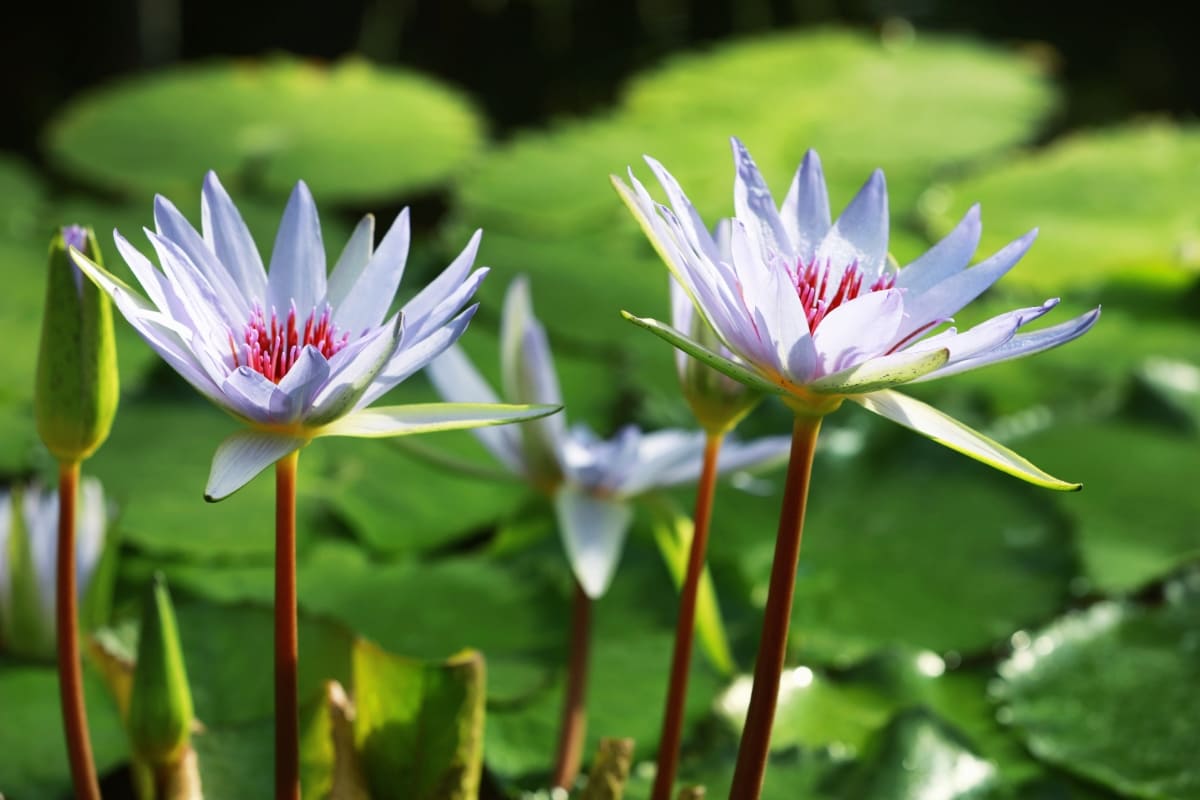Growing lotus from seeds can be a rewarding and fulfilling experience for gardening enthusiasts. Here we will discuss step-by-step instructions on how to grow lotus from seeds and an overview of the time it takes for lotus seeds to grow into beautiful plants.

How to Grow Lotus from Seeds
Understanding the Lotus Plant and its Seeds
The lotus plant, scientifically known as Nelumbo nucifera, is a beautiful aquatic plant known for its vibrant flowers and large, round leaves. It holds great cultural significance in many Asian countries and has been revered for centuries. To grow lotus from seeds, it is important to understand the plant and its seeds.
Lotus seeds are typically found inside the seed pods of the lotus plant. These pods develop after the lotus flowers have bloomed and are usually found floating on the water’s surface. The seeds are enclosed within a hard shell, which protects them from damage and allows them to float and disperse.
Selecting the Right Lotus Seeds for Growing
When selecting lotus seeds for growing, it is essential to choose healthy and viable seeds. Look for seeds that are plump, firm, and have a light brown to dark brown color. Avoid seeds that are shriveled, discolored, or damaged, as they may not germinate successfully. One way to test the viability of lotus seeds is to place them in a bowl of water. Viable seeds will sink to the bottom within a few hours, while non-viable seeds will float or remain suspended in the water. It is advisable to select the seeds that sink as they have a higher chance of germination.
In case you missed it: The Best Fertilizer for Lotus: When and How to Apply

Preparing the Ideal Growing Environment for Lotus Seeds
They should be exposed to at least six hours of direct sunlight each day. Choose a location in your garden or pond that receives ample sunlight throughout the day. They require a minimum water depth of 12 to 24 inches for optimal growth. The water should be clean and free from pollutants. Ensure that the water is changed regularly to maintain its quality.
Can lotus seeds grow in soil? Yes. They need soil to grow. Lotus plants prefer a mix of clay and loam soil. The soil should be rich in organic matter and have good water retention properties. The ideal pH range for lotus plants is between 6.0 and 7.5. They prefer temperatures between 24-35°C during the day and 15-21°C at night. If you live in a region with cold winters, you may need to protect your lotus plants by moving them indoors or using a frost cloth to cover them.
Soaking for Optimal Lotus Seeds Germination
- Fill a container with room-temperature water. Avoid using chlorinated tap water, as it may hinder germination. Instead, use filtered or distilled water for best results.
- Place the lotus seeds in the water and allow them to soak for approximately 24 to 48 hours. During this time, the seeds will absorb water and swell up.
- Change the water every 12 hours to prevent the accumulation of any harmful substances released by the seeds.
- After the soaking period, carefully remove the lotus seeds from the water. They should now appear plump and swollen.
Sowing Lotus Seeds in Containers or Pots
- Fill the container or pot with a soil mix designed for aquatic plants. Avoid using regular garden soil, which may be too heavy and compact.
- Make a small indentation in the soil, approximately 1 inch deep. Place a single lotus seed in the indentation, positioning it horizontally with the pointed end facing up.
- Gently cover the seed with soil, ensuring it is completely buried but not overly compacted.
- Place the container or pot in a sunny spot with at least 6 hours of sunlight exposure daily. Lotus plants thrive in warm, sunny conditions.
Providing Adequate Water and Moisture for Lotus Seedlings
- Water Quality: Ensure that the water you use is clean and free from contaminants. Using tap water is generally safe, but allow it to sit for 24 hours to dissipate any chlorine present. Alternatively, collect rainwater or use well water.
- Water Depth: For young lotus seedlings, maintain a water depth of 2-4 inches. As the plants grow, gradually increase the water depth to 12-24 inches, depending on the lotus variety.
- Water Temperature: Lotus plants prefer water temperatures between 24-30°C. Use a water thermometer to monitor and maintain the desired temperature range.
In case you missed it: How to Use Grow Lights for Indoor Seedlings: Best Grow Light Setting for Seedlings

Maintaining the Ideal Temperature and Light Conditions for Lotus Growth
Temperature: Lotus plants prefer warm climates. During the growing season, maintain an ambient temperature between 24-35°C. Protect the plants from frost during colder months and ensure they receive adequate warmth.
Light: Lotus plants require full sun exposure for at least six hours a day. Ensure they receive direct sunlight by placing them in a location with minimal shade. If growing lotus indoors, use artificial grow lights to provide the necessary intensity and duration.
Fertilizing Lotus Plants to Promote Healthy Growth
- Use a slow-release fertilizer specifically formulated for aquatic plants. They contain vital nutrients such as nitrogen, phosphorus, and potassium in balanced proportions.
- Start fertilizing your lotus plants once they have established a few leaves.
- Apply a small amount of fertilizer every two to three weeks during the growing season. Reduce frequency during the dormant period.
- Dissolve the recommended amount of fertilizer in water and gently pour it into the water surrounding the lotus plants.
- Ensure the fertilizer is evenly distributed and avoid direct contact with the leaves.
Protecting Lotus Seedlings from Pests and Diseases
Regularly inspect your lotus seedlings for any signs of pest infestation and diseases. Common pests that affect lotus plants include aphids, snails, and caterpillars. If you notice any pests, take immediate action to control and eliminate them. Organic pest control methods like handpicking or using natural insecticides can effectively manage infestations. At the same time, beware of Pythium, Fusarium, and Verticillium fungal infections in lotus plants and application of fungicides is recommended when necessary.
Transplanting Lotus Seedlings Into a Pond or Water Garden
Select a Suitable Container: Use a wide, shallow container with drainage holes, such as a plastic pond basket or a fabric grow bag. This allows the lotus roots to spread out and establish successfully.
Planting Process: Fill the container with a mixture of loam soil and clay. Gently place the lotus seedling in the center of the container, ensuring that the growing tip is facing up. Cover the roots with soil, leaving the growing tip exposed.
In case you missed it: 10 Factors Affecting Seed Germination Times: Internal and External Factors

Submerge the Container: Carefully submerge the container in the pond or water garden, ensuring the top of the container is at the appropriate water depth. This allows the lotus leaves to float on the water surface while the roots remain submerged.
Maintenance: Regularly monitor the water level and ensure consistency. Fertilize the lotus plants with a balanced aquatic plant fertilizer, following the manufacturer’s instructions. Remove any dead leaves or debris from the pond to maintain cleanliness.
How Long Does Lotus Take to Grow from Seed?
Lotus seeds require specific conditions and care to germinate and develop into mature plants. It can take anywhere from two weeks to two months for seeds to germinate. The sprouting process begins after germination. A seedling’s roots will penetrate the mud as soon as it emerges from its seed coat. An average lotus plant grows from seed to fully bloomed flower in 18 to 24 months.
Which Month is Best for Planting Lotus Seeds?
In the spring, when temperatures are rising and the risk of frost has diminished, lotus seeds are best planted. You can enjoy the beauty of lotus flowers in your garden or pond if you provide the right conditions and care.
Conclusion
Growing lotus from seeds requires patience and care, but the reward of seeing these magnificent plants bloom is worth the wait. By following the steps outlined in this guide and providing the necessary growing conditions, you can enjoy the beauty of lotus flowers in your garden or pond.
- Feed Your Flock for Less: Top 10 Tips to Save on Chicken Feed
- Ultimate Guide to Ossabaw Island Hog: Breeding, Raising, Diet, and Care
- Hatching Answers: The Top 10 Reasons Your Chickens Aren’t Laying Eggs
- Eggs and Economics: Breaking Down the Cost of Raising Backyard Chickens
- Defend Your Greens: Proven Methods to Keep Iguanas Out of Your Garden
- Ultimate Guide to Cinnamon Queen Chicken: A Comprehensive Guide for Beginners
- Ultimate Guide to California Tan Chicken: Breeding, Raising, Diet, Egg-Production and Care
- Ultimate Guide to Marsh Daisy Chicken: Breeding, Raising, Diet, and Care
- 10 Types of Chicken Farming Businesses You Can Start for Profits